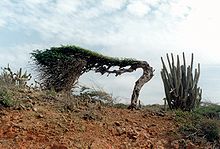- Caesalpinia coriaria
-
Caesalpinia coriaria 
Divi-divi on Aruba Scientific classification Kingdom: Plantae (unranked): Angiosperms (unranked): Eudicots (unranked): Rosids Order: Fabales Family: Fabaceae Genus: Caesalpinia Species: C. coriaria Binomial name Caesalpinia coriaria
(Jacq.) Willd.Synonyms Poinciana coriaria Jacq.[1]
Caesalpinia coriaria is a leguminous tree or large shrub native to the Caribbean, Mexico, Central America, and northern South America. Common names include Divi-divi, Cascalote, Guaracabuya, Guatapana, Nacascol,[1] and Watapana (Aruba).
Contents
Description
C. coriaria rarely reaches its maximum height of 9 m (30 ft) because its growth is contorted by the trade winds that batter the exposed coastal sites where it often grows. In other environments it grows into a low dome shape with a clear sub canopy space. Leaves are bipinnate, with 5-10 pairs of pinnae, each pinna with 15-25 pairs of leaflets; the individual leaflets are 7 mm long and 2 mm broad. The fruit is a twisted pod 5 cm (2.0 in) long.
The Divi-divi is one of the more well known species of Caesalpinia; it is the national tree of Curaçao.[2] It is also very common and popular on Aruba.
Tannins are extracted from Divi-divi pods for use in leather production.[3][4]
See also
References
- ^ a b "Taxon: Caesalpinia coriaria (Jacq.) Willd.". Germplasm Resources Information Network. United States Department of Agriculture. 2004-03-26. http://www.ars-grin.gov/cgi-bin/npgs/html/taxon.pl?8282. Retrieved 2011-04-18.
- ^ Sullivan, Lynne M. (2006). Adventure Guide to Aruba, Bonaire & Curaçao. Hunter Publishing Inc. p. 10. ISBN 9781588435729. http://books.google.com/books?id=M8SyFOyvjkQC&dq.
- ^ "Vegetable tannins". Bookbinding and the Conservation of Books. Conservation OnLine. 2011-03-10. http://cool.conservation-us.org/don/dt/dt3686.html. Retrieved 2011-04-18.
- ^ Perez-Tello, Carlos (1995). "Recovery of Vegetable Tannins from Divi-divi Pods". Journal of Chemical Technology & Biotechnology 64 (1): 101–104. doi:10.1002/jctb.280640116.
External links
 Media related to Caesalpinia coriaria at Wikimedia Commons
Media related to Caesalpinia coriaria at Wikimedia Commons  Data related to Caesalpinia coriaria at Wikispecies
Data related to Caesalpinia coriaria at WikispeciesSources of condensed tannins Areca catechu seed (arecatannins) | Broad bean (Vicia faba) | Grape (Vitis vinifera) | Quebracho wood | Mimosa bark (Acacia mollissima) | Myrtan or black marlock (Eucalyptus redunca)Sources of hydrolysable tannins Chestnut wood | Dhawa (Anogeissus latifolia) | Myrobalan fruit (Terminalia chebula) | Oak wood, bark or acorn cup (Valonea Quercus macrolepis) | Sumac (Tanner's sumach leaves - Rhus coriaria or Chinese gall on Rhus chinensis) | Tara pod (Caesalpinia spinosa)Other sources Alder (Alnus sp) | Avaram (Senna auriculata) | Babul (Acacia nilotica) | Birch (Betula sp) | Larch (Larix sp) | Hemlock (Tsuga sp) | mangrove | Pine (Pinus sp) | Spruce (Picea sp) | Urunday (Myracrodruon urundeuva) | Willow (Salix caprea)Cutch (Acacia catechu)Whole plantProsopis sp. bark and wood (eg Prosopis humilis or Algarrobilla) | Tanoak (Lithocarpus densiflorus) | Tizra heartwood and root (Rhus pentaphylla)Misc Categories:- Caesalpinia
- Plants described in 1799
- Symbols of La Guajira
- National symbols of Curaçao
- Trees of the Caribbean
- Trees of Central America
- Trees of Colombia
- Trees of Mexico
- Trees of Venezuela
- Trees of Guatemala
Wikimedia Foundation. 2010.


